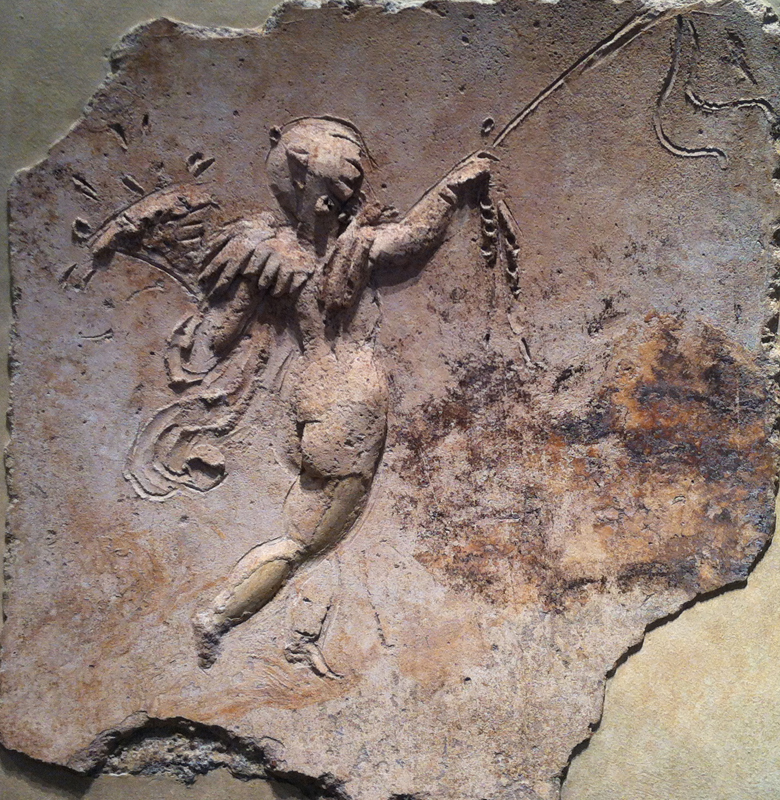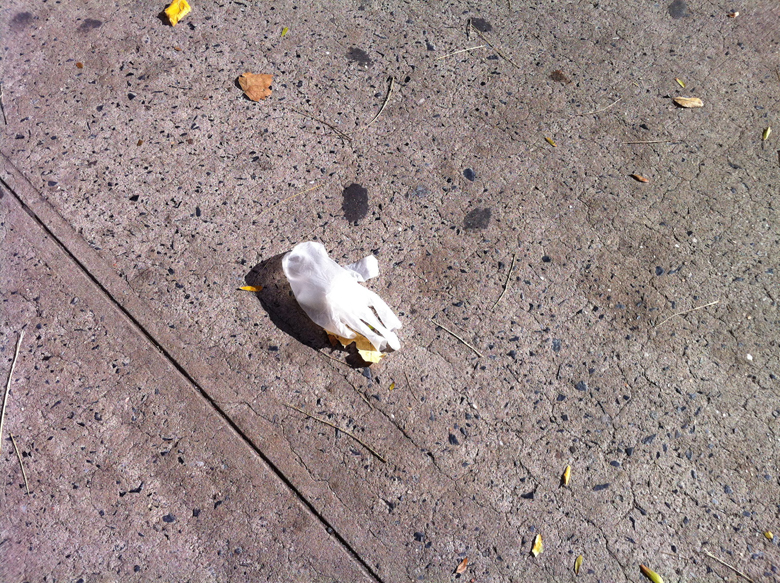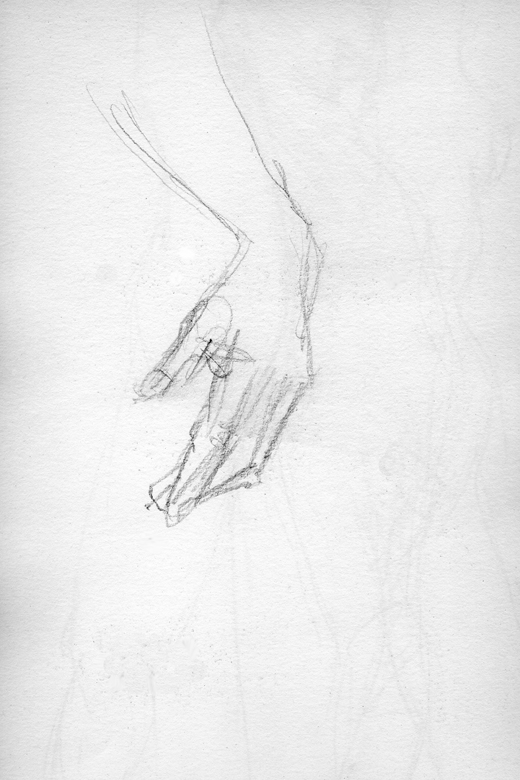LX
The Hand of Apelles. It triumphs in a contest against the hand of his contemporary Protogenes in their duel, described by Pliny, to paint the finest possible line. Holbein the Younger depicts The Hand as it emerges from the clouds to make the fabled master stroke in a 1521 edition of Erasmus’s Enchiridion militis Christiani (Handbook of a Christian Knight). References to Appeles’ Hand, and the line that issues from it, implicitly connecting the divine and earthly realms, pop up like so many Renaissance weeds. And who but Apelles, so near to the gods as to seem himself godly, could render the countenance of Venus herself?
But ultimately, does not Apelles’ “immortality” lie in his capacity to leave his work incomplete, or, as Pliny puts it, to know how “to lift his hand from the painting”?
No Pliny yet for this latter-day Apelles. But here, a trace from Divided We Stand (pub. 1999, 2011):
There are days when the World Trade Center lies shrouded in mist, invisible from your living room window three miles to the north. Here, twenty stories up, in one of the tallest buildings in the “valley” between the downtown and midtown towers, a hundred years of development vanishes from sight. On a clear day, though, you can see the visible evidence left by New York’s master builders in their headlong rush through the twentieth century. Far to the southwest, beyond a sliver of Hudson, you can make out the bold arch of the Bayonne bridge, rising above the horizon like a half-buried, cyclopean Ferris wheel. At night the Bayonne’s bow of lights might be the diadem of a vast Odalisque, reclining across the industrial heartland of New Jersey.
This is the first bridge that Othmar H. Ammann designed for the Port Authority. Linking New Jersey and Staten Island by highway, Ammann pushed arched metal as far as physics would allow. So strikingly beautiful is its form that Berenice Abbot shot a series of giddy, nearly rapturous portraits soon after it opened to automobile traffic in 1931. That same year, Amman delineated the stunning proportions of the Port Authority’s George Washington Bridge, linking the Jersey Palisades with the northern tip of Manhattan and gesturing eastward toward the Bronx and Long Island.
As you look southeast over the roofs of Greenwich Village, SoHo, Little Italy and Chinatown, the massed skyscrapers of Wall Street rear up their impenetrable collective curtain wall. Beyond them lies Ammann’s greatest engineering triumph: the Verrazano Narrows, a ribbon of motor vehicles spanning the strait between Brooklyn and Staten Island, stretching over freighters passing into the bay, or out into the Atlantic. Its building commanded by Robert Moses in the mid-1960s, the Verrazano finally completed the automotive link between New Jersey and Long Island that the Regional Plan Association had called for thirty years before.
Twenty square blocks of residential Bay Ridge crumbled before Moses’s bulldozers to clear the way for the Verrazano’s Brooklyn anchorage. When built, the Verrazano, like the Bayonne bridge had in its day, extended the limits of metal engineering with masterful delicacy. So long is the span that its twin vertical piers are not built perfectly parallel to one another. To accommodate the curvature of the earth, they veer an inch and five-eighths farther apart at their tops than at their mooring in the Narrows mud seventy stories below. Ammann had learned over a lifetime of engineering that great strength does not require great mass. His vision for this last great New York bridge was of “an enormous object drawn as faintly as possible.”
Mr. Invisibility. Mr. Popular.
The mountain of youth.
Ventoux. Sainte-Victoire. Tai. Longhu…
Ah, the half buried tracks of the old C&M (Cézanne & Matisse) railroad.
Red rust. Crumbling ties.
Juiced, comme il faut.
德 De (ti) [as in Dao De Jing: originally a combination of the characters for footstep (chi) and straight (zhi). Later, heart (xin) was added. As in Dao De Jing, it is frequently translated as: virtue, morality, ethics. But it also implies the idea of potential or power. Arthur Waley writes that the early Chinese saw de as “bound up with the idea of potentiality. Fields planted with corn represent potential riches; the appearance of a rainbow, potential disaster; the falling of ‘sweet dew,’ potential peace and prosperity. Hence de means a latent power, a virtue inherent in something. [The Way and Its Power…]
Tom Bisio comments that, beyond potential or latent power, De signifies the capacity to “freely exercise our natural ability,” and further, that our “natural, inherent ability is our De and in effect makes us who or what we are.” [Decoding the Dao: Nine Lessons in Daoist Meditation]
Caveat lector, apparent detour:
Jullien, in discussing the plenitude of the sketch in The Great Image… calls into relief the connotation of De as “virtue” in relation to “capacity,” and by extension efficacy: The strategy, the Laozi tells us, is to keep the effect coming and not let it come about completely. The effect must be sketchy to remain effective. As soon as the effect has come about, has drawn attention to itself, it is lost: “When everyone knows the beautiful as beauty, then already it is ugly”; “when everyone knows the good as good, then already it is not good.”… When everyone admires, when everyone recognizes the effect, there is already nothing left to recognize or admire. Thus the Laozi later says that “the effect takes form” but the sage “does not dwell in it,” and that “it is only because he does not dwell in the effect” that “the effect does not leave him.” That “dwelling in the effect” is wrong because, by attributing the effect to yourself, the way you might occupy a place, you make the effect more precarious, which inevitably gives rise to resistance and rivalries, producing a certain counter effect. But that is not all. I believe it is wrong in the first place because the effect dries up and loses its effectiveness as soon as it is constituted as a “place” that can be possessed, hence delimited, as soon as it objectively shows off as effect.
It seems to me we can read the formula with which the Laozi begins – in what is believed to be its original order – in the same way:
Higher virtue is not virtuous,
that is why it possesses virtue;
lesser virtue does not forsake virtue,
that is why it is without virtue.
Once again, this is not a paradox, but a return to the buried source of the effect. The apparent contradiction of the formula contrasts the overt, recognized (and lost) effect with the effective effect. Lesser virtue – or better, lesser capacity (de) – is that which has virtue and effect as an objective and hence cleaves to them. It produces only acts of virtue or isolated effects, all of them intentional. Although they are recognized as such, these effects do not constitute a mode of conduct that generously radiates virtue, or a capacity for effect that is universally and repeatedly at work. That lesser capacity is too painstaking to give the effect a clear enough field to deploy and spread. The effect bogs down and becomes entrenched, and its self-sufficiency dissolves; it can no longer work. That is, the effect’s attachment to itself (it does not “forsake” itself), destroys, by virtue of the effect’s self-sufficiency and self-approval, the (infinite) possibility for effect. Conversely, higher virtue (capacity) is effectively virtuous (efficacious) because it does not claim to be so. Rather, forsaking the aim of a particular effect – an aim that always circumscribes – higher virtue lets the effect’s fount of immanence operate inexhaustibly, without restriction. The effect that does not show itself as such (as effect) is all the more effective in not being produced (and expended) by name. It remains indefinitely implicit and, working upstream, does not allow itself to be lessened by the rigidity and limitations of the concrete.
So… regarding the sketch, again Jullien:
Absence or at least what appears absent from the later viewpoint of the definitively actualized, limited, and rigid effect [the finished painting] is thus an integral part of the effect:
Great completion is seemingly lacking,
but it is never used up…
because that completion is always at work… In “seeming to be lacking,” the sketch is truly the “great” completion. That is, it works as compossibility and cannot be reduced to the phenomenon of holding back – in understatement, for example – whereby less is more. It prevails not by virtue of its economy but by virtue of its availability.

So yeah, I was waiting for Lefty, Godot and the rest of the gang down at the five corners: Division, Compossibility, Bond, Dialectic and Center…


